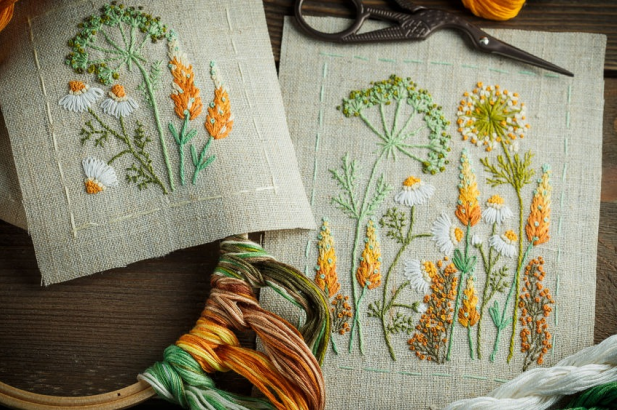
The importance of choosing the “right” fabric for your project – so that your carefully worked hand embroidery which may well take you hours of concentration – looks its best can’t be emphasised too much. The fabric upon which you work your design is just as important as the threads, colours and stitches you choose – and sometimes even more so.
Any fabric can be embellished with embroidery, but some are much more suitable than others. Always choose the nicest fabric you can afford as, in fabric, as with many other things, you get what you pay for! Don’t spend time and effort on a project worked on cheap, poor-quality fabric that isn’t suitable for hand embroidery. Even if you don’t run into any other problems, the fabric won’t last as long and your embroidery won’t look as nice as it could have done.
All woven fabric has a grain – both lengthwise and crosswise – the grain refers to the weave of the fabric. The lengthwise grain runs parallel to the selvedge whilst the cross grain runs at right angles. Finally there’s the bias which runs diagonally across the fabric. Squaring up your fabric so that you can hoop up on the grain will give you better results as mounting your fabric “off grain” or at an angle to the direction of the weave often leads to puckering or warping.
You also need to consider the type of stitching you’re planning to work when choosing your background fabric – it needs to be able to support your work. Denser, heavier stitching will usually require a heavier weight fabric with a fairly close weave that will support your stitching. The opposite is also true – light delicate stitching will disappear into a heavy fabric such as hessian.
And finally, consider how your finished work will be used before deciding upon your fabric. If your project will be laundered then choose a fabric (and floss too of course) that will be able to stand up to this. When working with linens and cottons if you’re unsure of the provenance then it’s a good idea to pre-shrink them before beginning work.
Want more hints & tips? Then click below to get our free newsletter – you’ll even get some fab free patterns too…
*Article originally appeared in Bustle & Sew Magazine. Find out more HERE
What stunning work,and great information.x
So pleased you found it helpful! xx